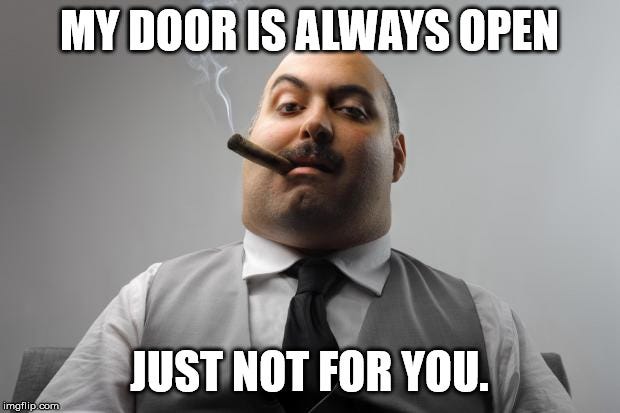Transparency can sound bossy.
Direction has become a villain in management circles. You know, you should lead, not direct, right?
But without clarity and decisiveness, how can you be transparent? What others experience instead is micromanagement and harsh truth (the old honest and bad feedback).
Hmm. Let’s flip transparency in your favor.
Today you will read about how to lead your team with transparent communication, not bossiness.
Assumptions, assumptions, assumptions
Again and again, we touch on assumptions.
Assumptions ruin communication and block collaboration. When expectations aren’t clear, you rely on free will, the ability to prioritize, the workload, and the accountability of your team.
It is probably not the best strategy.
Employees waste time guessing what’s needed or redoing tasks. Their prioritization is often off and they let themselves be steered by stress and procrastination.
(coffee breaks, wink wink)
4 arguments for you to consider:
Misunderstandings cost time and hinder productivity
What is clear to you isn’t always clear to others (expect not to be understood!)
Lack of clarity influences confidence
Clarity supports accountability
While many leaders think they communicate well, their real and vague communication leads to confusion and mistakes.
You say:
“Prepare project materials.” (until when, which format, based on what information?!)
“We need to improve these reports.” (how?!)
You should be saying:
“By Wedsneday noon, share with me a project overview based on clien’t materials saved here, use the same template as we did in the last project reference XX.”
“ Let’s make the reports clearer by adding a summary and key insights upfront.”
Too many details? Transparent communication loves details! Does it sound bossy? No! Unless you speak like a robot.
When you say it proudly and in support, no one will label you bossy.
Honesty (with a tea bag)
I love tea. I’ve been trying to convert my friend from into tea drinking, but he’s a hopeless coffee lover.
But now, you’re my target. I will brew honest tea for you.
What happens to a tea bag when you put it into boiling water? It softens and fuses the goodness. Can you smell it already?
Being transparent doesn’t mean being blunt or rude. Imagine honesty without harshness. Can you share truth in a way that encourages, not demotivates?
It falls into the topic of how emotionally intelligent people give feedback we spoke about a couple of weeks ago.
A tea bag is a metaphor for being mindful of your arguments. Constructive honesty allows people to recognize areas for improvement without feeling attacked. This builds trust and preserves relationships, just like drinking a cup of team together.
How to be honest then:
Avoid making it personal, focus on behavior.
Open doors to collaboration. Instead of pointing out a problem, ask to come up with solutions together.
Be honest about the good, the bad, and the ugly. People tend to be honest about ‘bad’ things, balance that, and appreciate others and what they do, too.
The true open doors
“My door is always open.”
Is it? So why don’t people come and talk to you?
The open-door policy is a nice idea many leaders adopted. But when no one is coming to speak up due to fear of judgment, or ignored inputs, it shows something isn’t working.
You don’t realize you might act bossy. If you dismiss employees’ problems, small issues, and psychological safety, you might be soon facing big challenges.
The truly open door is more about actively approaching your team and asking for their feedback. That is the way to avoid being bossy and more transparent.
Catch concerns, reach out to see how they are doing, and listen without distractions.
Make your door transparent.
Direction & transparency
It is your problem. You take this project. The team implements this.
If these statements feel like dumping problems on your team, you’re right. What would make them more transparent and less directive is beloved “why”.
“WHY” behind decisions and providing guidance is probably the best strategy to lead your team with transparency and not bossiness.
People fear when they don’t know or understand what is happening. Clear communication helps them stay focused and engaged.
My favorite is talking about the big picture. For trees, you don’t see the forest. And so it works with daily tasks. Email after email until you are lost in a job you don’t like.
However, when you understand the rationale, you are likely to make better choices and priorities. Pair honesty with support and you get people forward.
That isn’t bossiness, it is your ability to clearly communicate what you need and on the other side, you team asks for what they need.
Instead of "Leadership decided this," say, "Based on market trends and feedback, we’ve made this decision to stay competitive. Here’s what it means for us."
Your team then say, “Okay, this resource we need to reconsider and this project has to be postponed in favor of a new initiative.”
Direction is a combination of dialogue, transparency, and collaboration.
We will practice this and a lot more in the online course The 4 Pillars of Leadership Communication, which starts in May. Work with me.
TL;DR
So tell me now, boss. What do you choose? Transparency or direction?
Both and tea with them.
Have a good one, Ivona
On the menu:
Thursday Newsletter: How to Resolve Workplace Disputes Across Screens







